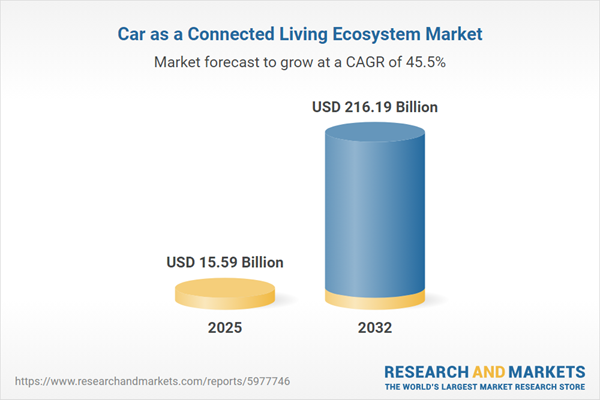Speak directly to the analyst to clarify any post sales queries you may have.
The car as a connected living ecosystem market is rapidly evolving, transforming vehicles into digital environments that extend far beyond transportation. Senior automotive leaders are confronting new opportunities to unlock advanced services, harness operational efficiencies, and strengthen stakeholder collaboration within a modern, data-driven mobility landscape.
Market Snapshot: Car as a Connected Living Ecosystem
The car as a connected living ecosystem market is experiencing strong expansion, highlighted by substantial growth rates and a rising market value forecast for the next decade. This momentum is shaped by the increasing enterprise demand for seamless digital interfaces, next-generation safety mechanisms, and the widespread deployment of real-time, cloud-enabled maintenance tools. Automotive organizations—both in passenger and commercial domains—are sustaining investment responses to ongoing regulatory shifts, changing mobility demands, and flexible service model adoption. The integration of digital platforms and data-centric operations is transforming the automotive value chain, driving the development of innovative business models and unlocking new opportunities for stakeholder value globally.
Scope & Segmentation: Car as a Connected Living Ecosystem Market
This executive market research report equips senior decision-makers to assess connected car technologies, implement digital transformation strategies, and navigate the complexities of compliance in a fast-paced automotive sector. Segmentation provides a detailed understanding of both tactical and strategic growth levers across core areas:
- Application Types: Infotainment platforms deliver integrated navigation, multimedia, and enhanced safety features, elevating in-car user experiences. Telematics power fleet optimization, insurance programs, and enable compliance, while predictive diagnostics streamline vehicle maintenance and minimize downtime.
- Connectivity Technologies: Bluetooth, 4G/LTE, 5G, dedicated short-range communications, and Wi-Fi provide secure, remote vehicle access and efficient management of vehicle data. These technologies enable reliable, real-time operations required for next-generation connected vehicles.
- Service Types: Bundled, pay-per-use, and subscription-based services deliver scalable solutions that appeal to both enterprise customers and end users, fostering flexibility in how automotive digital services are consumed and monetized.
- Vehicle Types: The market encompasses passenger cars and commercial fleets, each demanding robust cybersecurity, compliance protocols, and intuitive digital interfaces tailored to their specific operational needs.
- Regions: The Americas, Europe, Middle East and Africa, and Asia-Pacific reflect diverse adoption trends. Distinct regulatory dynamics and unique technology ecosystems across these areas define investment opportunities and strategic directions for regional and multinational stakeholders.
- Leading Companies: Prominent players such as Robert Bosch GmbH, Continental Aktiengesellschaft, DENSO Corporation, Aptiv PLC, Samsung Electronics Co., Ltd., Qualcomm Technologies, Inc., NXP Semiconductors N.V., ZF Friedrichshafen AG, NVIDIA Corporation, and Mobileye Global Inc. are continuously innovating in hardware and software, shaping market advancements and competitiveness.
Key Takeaways
- Connected vehicles have become essential digital platforms, enhancing collaboration among automotive firms, technology providers, and end users.
- Adoption of cloud-native solutions and advanced analytics supports remote diagnostics, predictive maintenance, and the creation of agile service portfolios for evolving networked vehicles.
- Industry leaders focus on operational streamlining to navigate shifting regulatory demands and build resilient, future-ready supply chains.
- Fleet managers employ analytics and telematics to boost asset performance, extend operational life, and better justify connectivity investments to stakeholders.
- Strategic collaboration among original equipment manufacturers, suppliers, and network experts is vital in achieving compliance and supporting effective, sustainable deployments at scale.
Tariff Impact: Implications for Supply Chains and Innovation
Recent adjustments to U.S. tariffs are prompting leading automotive organizations to evolve sourcing and supply chain approaches. Companies are diversifying their supplier bases, prioritizing local procurement strategies, and implementing modular manufacturing to strengthen operational resilience. These steps enhance innovation while managing risk associated with regulatory changes, directly supporting continued investment in vehicle connectivity.
Methodology & Data Sources
This analysis draws on structured interviews with senior automotive and technology executives, comprehensive regulatory reviews, proprietary data sets, and leading industry benchmarks. The multi-source methodology ensures that insights are actionable and robust for executive-level strategic planning.
Why This Report Matters
- Provides targeted insights to guide automotive leaders in planning and executing connected car strategies and digital investments.
- Empowers stakeholders through benchmarking and strategic partnership recommendations to drive ecosystem value and business growth.
- Equips organizations to address regulatory complexity and operational challenges inherent to the fast-evolving mobility sector.
Conclusion
As automotive connectivity sets new operational standards, deliberate technology adoption, robust data governance, and cross-industry collaboration position organizations to excel and remain competitive in a transforming mobility environment.
Additional Product Information:
- Purchase of this report includes 1 year online access with quarterly updates.
- This report can be updated on request. Please contact our Customer Experience team using the Ask a Question widget on our website.
Table of Contents
3. Executive Summary
4. Market Overview
7. Cumulative Impact of Artificial Intelligence 2025
Companies Mentioned
The companies profiled in this Car as a Connected Living Ecosystem market report include:- Robert Bosch GmbH
- Continental Aktiengesellschaft
- DENSO Corporation
- Aptiv PLC
- Samsung Electronics Co., Ltd.
- Qualcomm Technologies, Inc.
- NXP Semiconductors N.V.
- ZF Friedrichshafen AG
- NVIDIA Corporation
- Mobileye Global Inc.
Table Information
| Report Attribute | Details |
|---|---|
| No. of Pages | 188 |
| Published | October 2025 |
| Forecast Period | 2025 - 2032 |
| Estimated Market Value ( USD | $ 15.59 Billion |
| Forecasted Market Value ( USD | $ 216.19 Billion |
| Compound Annual Growth Rate | 45.5% |
| Regions Covered | Global |
| No. of Companies Mentioned | 11 |









